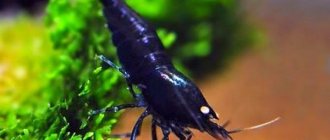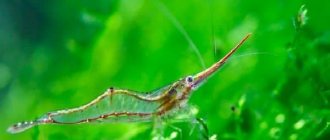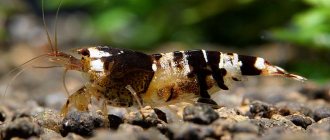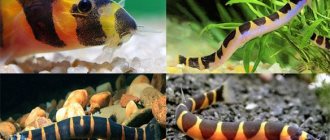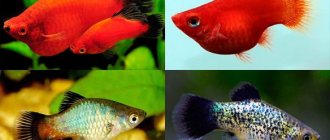Not so long ago, in two thousand shaggy years, or rather in 2006, thanks to new research on Japanese shrimp, it was established that the shrimp Caridina japonica (discovered and described in 1892) and the shrimp Caridina multidentata (previously described in 1860) are one and the same look. Thus, since 2006, the name of the shrimp has been officially changed to “Caridina multidentata”. Takashi Amano , the father of all aquascapers and the founder of the Nature Aquarium direction, was the first to use Caridina multidentata to combat algae. It was Sensei Amano who first discovered their remarkable ability to eat filamentous algae. Realizing that, Dad immediately ordered several thousand shrimp from a local trader, cultivated them at home, and thereby popularized them throughout the world. Since the 1980s, aquarists began to call caridin multidentata in honor of the Great Maestro - “Amano Shrimp”.
Takashi Amano
On a note. There is another commercial name for these AES shrimp - Algae (Algae) Eating (Eating) Shrimp (Shrimp). In this article, we will call the shrimp nothing more than “Amano Shrimp”. Father must be respected and honored!
In nature, shrimp live in the south-central part of Japan, Southern China; they were recently discovered on the island. Taiwan. Amanki live in fresh, clean rivers and streams flowing from the mountains and flowing into the ocean. Sea water plays an important role in their lives.
The fact is that only adult shrimp live in fresh water, and Amano shrimp larvae hatch into the sea, feeding on sea plankton. Then the grown larvae return back to fresh waters. It is for this reason that shrimp reproduction is fraught with some difficulties. The female in the aquarium bears eggs, but as soon as the eggs float, they are doomed to death. See our forum about raising Amano shrimp at home.
We recommend watching our video
Keeping Caridina multidentata in an aquarium
Amano shrimp
The average size of shrimp is 3-5 cm (females are larger than males, growing up to 6 cm). The behavior of shrimps is non-aggressive; on the contrary, Amanks are the most harmless creatures. Water temperature - 22-28 C (they can easily tolerate lower temperatures. The main thing is without sudden fluctuations). PH 6.2-7.5, KH 3-8, GH 6-8 . IMPORTANT! Increased content of ammonia , nitrites , nitrates , oxygen-poor water, sudden changes in water parameters, addition of drugs (especially those containing copper - copper sulfate) to the water - all these factors can be detrimental to shrimp. Shrimp are also extremely sensitive to excess CO2. Because of these negative factors, Amanks climb up, trying to get out of the aquarium - they sit on the wires of the internal filter, cling to the tubes of the external filter, snags, plants - everything that is near the surface.
In such cases, you need to react quickly: eliminate the source of danger, replace some of the water with fresh water, and add hydrogen peroxide to the bottom of the aquarium.
Sexual dimorphism
Sexual dimorphism in the appearance of shrimp is expressed well enough to distinguish their sex. Females are noticeably larger and more voluminous than males; some individuals can reach a length of 6 cm, while males grow to a maximum of 4.
In females, the first row of dots and strokes located above the swimming legs merges into a line; in males, this pattern consists of unevenly distributed brown round dots. The swimming legs of females, which serve to hold eggs, are longer than those of males.
The lifespan of Amano shrimp is 5-6 years.
It is worth noting that Amano shrimp in an aquarium are very inconspicuous cockroaches. This feature was also useful to Takashi Amano when creating the “Nature Aquarium” concept, because in aquascapes the main emphasis is not fish or shrimp, but lush plants.
Amano shrimp Caridina multidentata
Recommendations for stocking density: minimum 1 shrimp per 5 liters . Takashi Amano advised keeping 40-50 pieces per 100 liters to combat threadbare. Those. The minimum team to combat filament should consist of at least 4 pieces for every 10 liters of aquarium water. The aquarium does not have to have a lid. But it should be borne in mind that these shrimp are very tenacious and quickly climb tubes, filters and plants. And if any of the above-described troubles occur in the aquarium, the shrimp can jump out of the jar in two. The color of shrimp varies depending on the diet from transparent greenish to transparent reddish. Dark dots and dotted lines about 1 mm are scattered on the sides of the body. It is interesting that males have only dots on their bodies, while females are decorated with both dots and dashes.
Amano shrimp Caridina multidentata
There are other shrimp that are similar to the Amano shrimp,
but the Amano shrimp has two or more dots on its tail. The rostrum (horn between the eyes) of the Amano shrimp is longer than that of other shrimp similar to it.
Amano shrimp Caridina multidentata
Like all shrimp, Amanki is constantly in search of food. Despite the fact that shrimps 24/7 sort through the soil, moss, plants, and cut off algae with their paws, it is still worth feeding them. The food includes: chips, pellets, sticks for fish, tablets for bottom catfish, spirulina, vegetables, bloodworms, spinach leaves, lettuce, etc. To meet the need for cellulose, especially during the molting period, it is advisable to place snags in the aquarium. By the way, all shrimp love dry leaves of almonds, birch, and walnuts; in the summer you can pick them, dry them, and periodically throw them into the aquarium to the delight of the shrimps. There are also specialized foods for aquarium shrimp. For example, Tetra Crusta Menu for a varied and nutritious diet of shrimp and crayfish.
At the same time, if the aquarium is shared with fish, then you shouldn’t worry much about the nutrition of the shrimp at all. They will find their own food - chewing algae and eating fish food that falls to the bottom.
Diet
All day long, shrimp wander around the aquarium in search of food, feeling every pebble and leaf; when they come across algae, they carefully cut it off with their small claws.
If there is a lack of algae, shrimp should be fed, otherwise this may negatively affect their life expectancy. Such feeding can be either specialized flakes and tablets with spirulina, or blanched zucchini, cucumbers, lettuce or spinach. The main thing is not to overdo it with food, as they may stop eating algae.
During molting, it is recommended to give shrimp food high in cellulose, which is necessary for rapid shell restoration.
What shrimp are Amano shrimp compatible with?
Shrimp Amano
In general, with everyone except Mahrobrachiums . However, on the FForum there are cases where Amano shrimp can declare a holivar to other shrimp - cherries, crystals, and others. Based on our practice, most likely we are talking about sick, weakened neighbors. For many years of maintaining herbal aquariums, our Amanks coexist perfectly with a herd of cherries, babaulti and others.
Amank compatibility
Amano Shrimp Compatibility Chart.
This type of shrimp has a rather peaceful disposition; very rarely they may try to eat the fry. But most often they themselves become victims of large fish. They can get along well in the same aquarium with any small fish. The only thing you need to watch out for is that during feeding they do not take food from smaller comrades and fish. Amanok can be combined with the following fish:
- cockerels;
- gourami;
- discus;
- barbs;
- Ancistrus.
They should not be placed in an aquarium if it contains:
- goldfish;
- angelfish;
- swordtails.
All these types of fish feast on amankas with great pleasure, especially young specimens.
The fight between Amano shrimp and algae
They say that Amanks have no equal in eating algae fouling. And it is true! The video below will convince you of this - BEASTS! Amano shrimp are 20 times more effective in this regard than the popular Red Cherry shrimp. There is an opinion that Red Cherries do not eat algae at all. We will not argue on this topic, but will figure out why Amano shrimp are so successful in the fight against threadworm. It's all about the special structure of the legs, or rather the claws.
The Amano shrimp has 4 legs with small claws at the end. The claws themselves have bristles. They are much tougher and more elastic than other shrimp. And each of the bristles (you can see it in the photo) is a tiny file. These bristles act as a scraper. The shrimp use them to scrape and cut off algal growths from the surface and immediately eat them.
Breeding
Gradually, the situation with the reproduction of shrimp in captivity is leveling out, but just a few years ago this was a very rare case. The fact is that it does not immediately produce a small copy of the shrimp, but a miniature larva.
And the larval stage passes in salt water, and then returns to fresh water, where it turns into a shrimp. So it’s quite difficult to lift a saltwater larva. However, now this is already possible.
How? I think to answer this question it is better to turn to experienced aquarists, and within the framework of this article I do not want to mislead you.
What algae do Amano shrimp eat?
Filamentous algae . Powerful lighting, CO2 and fertilizer supply are an excellent environment for their growth. Removing filamentous fish from an aquarium is difficult! And Amano shrimp easily cut down long threads of algae. Of course, don’t forget about the number of shrimp in the aquarium and that “hope for Amanok, but don’t make a mistake yourself” - you need to look for and level out imbalances: light, Redfield proportions, Mirko, substitutions, etc. Amano shrimp do not eat red algae: blackbeard and Vietnamese algae .
And no amount of these shrimp will help you fight this infection. Also, Amano shrimp are ineffective in combating hard, dark green spots on aquarium glass. It is very convenient to remove such points manually. For example, a plastic card or a scraper. Xenium specialists are theodoxus and neretina. To be fair, we note that some types of filamentous fish are difficult to eat. In general, if they are not hungry, the filament will thrive. Amano shrimp, for obvious reasons, are more interested in tasty fish food than algae. Hence our recommendations for destroying the thread:
1. Try to keep Amanok on dry rations.
2. Change some of the water. Carry out other procedures to level out the causes - do water tests, adjust Redfield, daylight hours, etc.
3. Apply any algaecide according to the instructions (usually it is recommended to apply it for three days). Amanks tolerate glutaraldehyde normally. And then wait for the shrimp to do the work. The algaecide will “burn the algae” - this will be visible, the same edogonium will turn pink, turn brown and wither. And in this state, Amano shrimp will easily cope with the task. They will quickly demolish any green thread to zero.
Selling Amano shrimp on the FF forum
The cost of Amano shrimp is high. In offline retail, a good price is 90-100 rubles. for an adult tail. In our city, for example, some SadoMazoZoo shops sell them even for 300 rubles. per unit. Wow!
Reproduction
Breeding Amano at home is a difficult and almost always impossible task! Most often, these shrimp are caught in the wild and then sold in pet stores.
Breeding Amano has some peculiarities. Since the larvae grow in salt water, you must first prepare a spawning aquarium. Shrimp cannot be bred in a community aquarium due to the following:
- Many aquarium fish do not tolerate increased water salinity, so they will die.
- Young individuals are often eaten by fish.
When the female is ready to spawn, a transparent egg sac appears under her tail. She begins to secrete chemicals that attract males. They mount the female and fertilize the eggs.
Amanok mating.
A couple of days after fertilization, dark green caviar drops into the egg sacs. The number of eggs can reach thousands. The female carries the eggs for just over a month. During this period, changes in her character can be replaced. She becomes more timid and often hides in algae. At this time, it is advisable to transplant it into a separate container.
Initially, the spawning aquarium contains fresh water, because... All the caviar will die in salted water.
The spawning aquarium is equipped with various shelters for the female, where she will hide. Next to it there should be a dim lamp that will work around the clock. In order for the water to be saturated with oxygen, it is necessary to install a small compressor with a tiny spray.
16:24
Amano shrimp. What is needed for breeding
After a month, the caviar will change color. It will become lighter. If you look closely, you can see the eyes of the embryos. The female immediately removes unfertilized or dead eggs on her own. When the larvae hatch, it is again transplanted into the general aquarium.
The hatched larvae are 1 mm in size. But already during this period they begin to actively feed on various microorganisms and even fish food.
Special salt for marine aquariums is added to the water. The salinity of the water should be 35 g/l. Water temperature 20-22°C. It is not possible to breed shrimp in fresh water. They will die within 4 days.
3-day Amano shrimp larva.
The larvae grow quickly; after 21 days they reach adult size. The salinity of the water at this moment is reduced by half. In an aquarium with larvae, 30% of the water volume is changed every week.
After two months, the young animals are transplanted into a common aquarium. In order for the transfer to be successful, an hour before the procedure, half of the salt water in the spawning aquarium is replaced with fresh water.
Notes and Recommendations for Amano Shrimp
1. If you are just going to buy these useful animals, know that, like any shrimp, they need to be gradually transferred to water from your aquarium. This is done simply - bring shrimp, pour them into a bucket and into a pan and go to the pharmacy for a dropper. Unfold the dropper, one end into the aquarium, the other into the container with shrimp, and then adjust the dropper so that it drips slowly.
Some very seasoned aquarists transfer shrimp this way for a whole day. Which is correct, especially when it comes to expensive items. At the same time, in practice everything can be sped up, 3-5 hours is enough. Um... ok... ok 1 hour)))
Again, in this matter, everything is individual and depends on the condition of your aquarium, as well as on how and where you got the shrimp. For example, if, after being sent to you by BlaBlaCar, they were shaking in the bag for three days, then it is better not to delay moving the shrimp to normal conditions.
To summarize, the main thing is not to pour the shrimp straight into the aquarium. For at least another hour, keep them in a basin and add water from your aquarium a little at a time. These actions will already prevent the death of a herd of shrimp from a sharp change in water parameters.
2. After you put shrimp in the aquarium, they usually boil at first and then disappear =) Quite often on the FForum they ask the question: “Where are my Amanks”? =) The answer is that they get stressed and sit in hiding. This is often a particular concern for owners of dense herbal plants, where it seems as if there are no Amanoks at all - they have died out. Don’t worry, relatively soon they will come out and crawl like impudent cockroaches throughout the aquarium.
The period of adaptation cache varies. It happens that they crawl out the next morning, and sometimes they are not visible for a week.
3. It’s no secret that all crustaceans molt periodically. Replacing the old chitinous shell with a new one is the only way to grow. During the molting period, it is especially important for shrimp to have a shelter where the animal remains until its new shell hardens. Also, molting is a way to restore lost limbs. Shrimp lose them under a variety of circumstances (fights in a bar, not bringing home a salary, etc. =). A shrimp can lose legs even during the molting itself - if it cannot remove any limb from the old shell, the leg comes off. In general, if you suddenly see a legless shrimp, don’t worry, the leg will soon grow back during the next molt.
The success of molting depends on many factors. One of them is the presence of calcium in water. Calcium is the basis of chitin for the shell. An element such as iodine is also very important. It is a coenzyme for the synthesis of chitin. If there is an iodine deficiency, there is a high probability that the shrimp will not be able to molt and will die. Therefore, if crustaceans live in your aquarium, iodinol is your best friend. Of the branded drugs, we can recommend Tetra Vital , which also contains iodine + vitamins.
Please note that iodine causes any shrimp to shed. You can even quickly notice it yourself. They added iodine and the very next day you can see “transparent skins” in the aquarium - old discarded armor, and their owners are already sitting in caches and growing new armor =) Don’t overdo it!
Additionally, please note that to start an aquarium with shrimp, we recommend using the Prodibo Starter Box Shrimp kit, which was described in detail in the article about starting a shrimp tank , read it! A good proven set of everything you need.
If you don’t need the whole set, but just need shrimp soil (soil) . Let's pay attention to a specialized soil that many aquarists have already used and are happy with - Dennerle shrimp king active soil.
This substrate is specially cut down according to the needs of the shrimp breeder. Good for lowering pH and kH and promoting plant growth in a shrimp aquarium.
Let me conclude this article... may the force be with you! Health to you and your hydrobionts.
Description
Amano is a large shrimp, average size is 5 cm. The body is segmented, flexible, consists of a cephalothorax, belly, and tail. There are 10 walking limbs attached to the thoracic region. The first of them, close to the head, are called maxillae, designed for capturing and pushing food into the mouth. In the caudal region, 2 pairs of legs are transformed into uropods - blade-shaped devices that, together with a fan-shaped tail, help the crustacean move in the water.
The cephalothorax is protected by a chitinous shell, and in front it narrows into a beak - rostrum. On both sides of it there are tactile and olfactory organs - 2 pairs of whiskers: long and short. The facet organs of vision are located on stalks, and at night they shine in the reflected ray of light.
According to the description, Amano is similar to other types of Taiwanese shrimp. You can distinguish it from its relatives by a pair of blue spots on the tail, as well as by a longer rostrum with noticeable teeth along the edges.
The body is transparent, decorated with red-brown speckles. Color can change depending on diet. When algae predominates, the body takes on a greenish tone. If the crustacean feeds mainly on protein foods, the color becomes reddish.
A little about molting
Shrimp have a shell. When they grow out of it, molting occurs: the old coating is shed and a new one grows. At a young age, Amano grow quickly, so shedding occurs once every two weeks or more often. Adults do this once a month. The shrimp eat the old shell. During the period of change of cover, these creatures are very vulnerable, so it is necessary to provide them with a sufficient number of shelters.
Shell of a faded shrimp.

